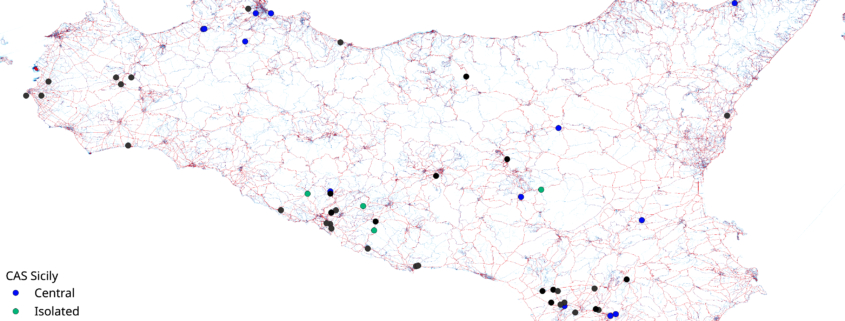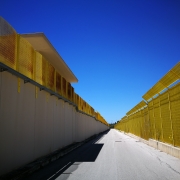Reception centres in Sicily are becoming increasingly isolated
Article first published on October 24, 2022
Since its beginnings, Borderline Sicilia has been monitoring the reception system for asylum seekers implemented by the Italian government. Over the years we have been able to ascertain and denounce the shortcomings of the system and the treatment reserved for people on the move.
In 2008, the CARAs* (reception centre for asylum seekers) were established, replacing the CIDs that were the first big centres for asylum seekers. In 2011, during the so-called North African Emergency, the management of the emergency reception system was entrusted to the Civil Protection and a number of centres were opened, including the CARA of Mineo, which is famous for its indecent living conditions and for the judicial scandals that have shown how organised crime has managed to infiltrate the management of many structures over the years. The underworld, which profits on the skin of the people arriving, could only generate a system of bad reception, as we have often called it and is still being called.
Several judicial proceedings and several journalistic investigations have shown how the CARA of Mineo, which was passed off as the flagship of Italian hospitality, was a place of choice for local mafias. It will probably go down in history, the statement of Buzzi, a partner of the group that managed the centre, intercepted during the operation Mafia Capitale; he said that migrants yield more than drugs. Not only local underworld, but also foreign underworld, with the internal management of the centre left at the mercy of the Nigerian mafia. There are dozens of articles of denunciation by local and national media and reports from organisations, showing how the CARA was the centre of a ring of drug dealing, prostitution, in several cases even child prostitution, and human trafficking. The same applies to other CARAs, outside Sicily, such as the CARA in Bari, which also ended up in a ruling by the European Court of Human Rights, which deemed it unsuitable to host asylum seekers with particular vulnerabilities, cancelling the transfer of an asylum seeker and thus derogating the Dublin Regulation, due to serious deficiencies within the Italian reception system.
The situation did not change when the CAS* (extraordinary reception centres) were set up in 2014, soon to become the primary form of reception. Contradicting its very acronym, extraordinary reception became ordinary, far outnumbering the CARAs and even the SPRAR* projects. In fact, in less than five years, the CAS have come to accommodate 80 % of asylum seekers, and despite the fact that the SPRAR system should have been the main reception and integration system, in reality, and also as a result of severely worsening regulatory interventions such as the 2018 security decree, this system is the one with the lowest capacity.
The CAS have thus become, and continue to be today, the foundation on which the reception of asylum seekers in Italy is based. We have often denounced how these centres have become mere dormitories where services aimed at integration into society are not provided, also due to increasingly less welcoming migration policies. These are often isolated centres, where people live in precarious housing situations, forced to cohabit in freight containers and fenced off by metal sheets. Small ghettos that dot the Italian landscape, located in places difficult to reach without their own means, set within economic geographies, made up of ploughed fields and crops, where asylum seekers are exploited for a few tens of euro a day. In fact, it is an inclusion within the irregular labour market that is generated by the exclusion of these subjects from civil society, from the urban world, confined and imprisoned on the margins of cities. Contemporary illegal recruitment of underpaid farm workers is a production of migration and asylum policies, as much as the deaths at sea in the Mediterranean.
As every year, Borderline Sicilia has requested, through generalised civic access requests, information on the various types of centres in Sicily..
The data in our possession refer to the acts prepared by the prefectures of the Sicilian provinces provided to us in February 2022, thus representing a snapshot of the moment, so it is possible that there are specific differences with today’s situation.
In this article, we analyse the data we have obtained and processed regarding the CAS. Specifically, we have placed the CAS within a map in order to show the isolation in which this type of centre tends to be placed. We adopted a street heat-wave map in order to show the urban and rural context in which many of the centres are located. In total, we count 68 centres, with a total capacity of 2,929 places, making the Sicilian system the second largest in Italy, after the Lombardy system, which, however, has twice as many inhabitants as Sicily.
The CAS are categorised on the basis of their overall isolation: the central ones are located within cities with more than 5,000 inhabitants, located in historic centres or in neighbourhoods provided with services; the isolated ones are located within towns with fewer than 5,000 inhabitants whose infrastructure does not allow the provision of basic services (such as the renewal of residence permits). The peripheral CAS are located outside cities, but still capable of using urban services. The rural ones, on the other hand, are located outside the urban context, in districts and the countryside, characterised by the near impossibility of movement by public transport and the absence of services.
As can be seen, more than half of the centres are in a peripheral or rural location. Most of the centrally located CAS are in the Palermo and Ragusa areas and a few scattered towns in the provinces of Messina and Agrigento. It should be noted that the province of Caltanissetta relegates any type of reception to the multifunctional centre “Pian del Lago” in which the CPR* (detention and repatriation centre) is located, which also houses the immigration office of the Police Headquarters, implying that for any service one must go to this rather isolated place instead of to the city. After the closure of the CARA of Mineo in July 2019, the province of Catania has slowly started to issue calls for tenders and promote allocation tenders for the management of CAS, but at the time of this photograph, only two CAS are open in the province of Catania.
It would be enough for the ministry to look at the same data it provides to understand that the great problem linked to the lack of real paths of integration and exploitation lurks within a short-sighted – or perhaps, on the contrary, too far-sighted – management of reception, which has generated a constellation of ghetto-camps in the suburbs and countryside of Sicily and Italy, draining public money into the hands of non-transparent private entities and seriously violating the rights of people who have come to Europe in search of protection and refuge.
Giuseppe Platania
Borderline Sicilia
*CARA: Centro di accoglienza per richiedenti asilo – Reception center for asylum seekers
*CAS: Centro di accoglienza straordinaria – Extraordinary reception center
*CPR: Centro di permanenza per il rimpatrio – Detention and repatriation center
*SPRAR: Sistema di protezione per rifugiati e richiedenti asilo – Protection facilities for asylum seekers and refugees. It is a communal reception system on a voluntary basis with about 3,000-3,500 places throughout Italy. It should serve for the integration of the refugees
Translated from Italian by Alexa Vittur


